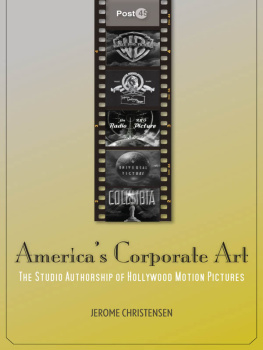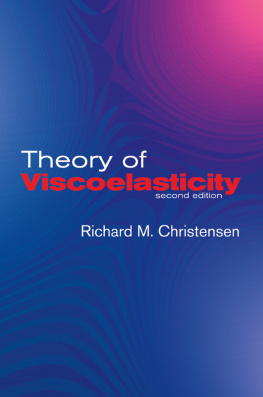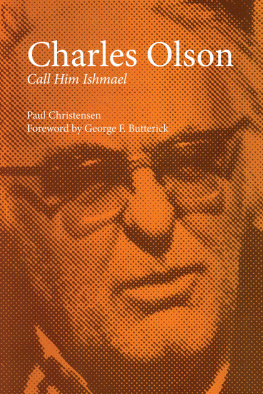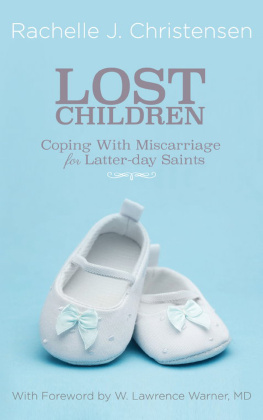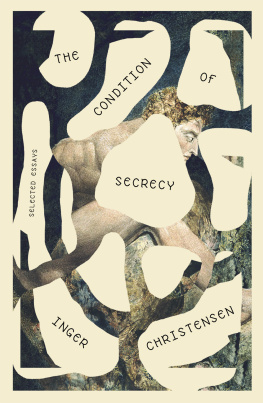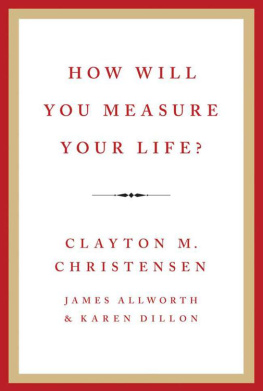Christensen - 2013;2012;
Here you can read online Christensen - 2013;2012; full text of the book (entire story) in english for free. Download pdf and epub, get meaning, cover and reviews about this ebook. City: California;Los Angeles;Hollywood;Hollywood (Los Angeles;Calif.);Stanford;CA, year: 2013;2012;2011, publisher: Stanford University Press, genre: Romance novel. Description of the work, (preface) as well as reviews are available. Best literature library LitArk.com created for fans of good reading and offers a wide selection of genres:
Romance novel
Science fiction
Adventure
Detective
Science
History
Home and family
Prose
Art
Politics
Computer
Non-fiction
Religion
Business
Children
Humor
Choose a favorite category and find really read worthwhile books. Enjoy immersion in the world of imagination, feel the emotions of the characters or learn something new for yourself, make an fascinating discovery.
- Book:2013;2012;
- Author:
- Publisher:Stanford University Press
- Genre:
- Year:2013;2012;2011
- City:California;Los Angeles;Hollywood;Hollywood (Los Angeles;Calif.);Stanford;CA
- Rating:3 / 5
- Favourites:Add to favourites
- Your mark:
- 60
- 1
- 2
- 3
- 4
- 5
2013;2012;: summary, description and annotation
We offer to read an annotation, description, summary or preface (depends on what the author of the book "2013;2012;" wrote himself). If you haven't found the necessary information about the book — write in the comments, we will try to find it.
2013;2012; — read online for free the complete book (whole text) full work
Below is the text of the book, divided by pages. System saving the place of the last page read, allows you to conveniently read the book "2013;2012;" online for free, without having to search again every time where you left off. Put a bookmark, and you can go to the page where you finished reading at any time.
Font size:
Interval:
Bookmark:

Florence Dore and Michael Szalay, Editors Post45 Group, Series Board
The Studio Authorship of Hollywood Motion Pictures
Jerome Christensen
Stanford University Press
Stanford, California
Stanford University Press
Stanford, California
2012 by the Board of Trustees of the Leland Stanford Junior University. All rights reserved.
All images from Grand Hotel are Copyright MCMXXXII in the United States by Metro-Goldwyn-Mayer. All images from The Crowd are Copyright MCMXXVIII in the United States by Metro-Goldwyn-Mayer. All images from Little Caesar are Copyright MCMXXXI Warner Bros. Pictures, Inc. All images from Gold Diggers of 1933 are Copyright MCMXXXIII Warner Bros. Pictures, Inc. All images from Boys Town are Copyright MCMXXXVIII in the United States by Loews Incorporated. All images from Mrs. Miniver are Copyright MCMXLII in the United States by Loews Incorporated. All images from Battleground are Copyright MCMXLIX in the United States by Loews Incorporated. All images from Singin in the Rain are Copyright MCMLI in the United States by Loews Incorporated. All images from The Band Wagon are Copyright MCMLIII in the United States by Loews Incorporated. All images from Executive Suite are Copyright MCMLIV in the United States by Loews Incorporated. All images from The Fountainhead are Copyright MCMXLIX Warner Bros. Pictures, Inc. All images from Vertigo are Copyright 1958 by Alfred J. Hitchcock Productions, Inc. All Rights Reserved. All images from Batman are 1989 Warner Bros., Inc. All images from JFK are 1991 Warner Bros. Regency Enterprises V.O.F. & Le Studio Canal+. All images from Youve Got Mail are 1998 Warner Bros. All images from Bonnie and Clyde are Copyright MCMLXVII by Warner Bros.-Seven Arts, Inc. and Tatira-Hiller Productions. All images from Pinocchio are Copyright MCMXL Walt Disney Productions, Inc. All images from Toy Story 2 are Copyright MCMXCIX Disney Enterprises, Inc. / Pixar Animation Studios.
Use of the WB in Shield Logo by permission from Warner Bros. Entertainment Inc. MGM Logo METRO-GOLDWYN-MAYER TM & 2011 METRO-GOLDWYNMAYER STUDIOS, INC. ALL RIGHTS RESERVED. Courtesy of MGM Media Licensing. RKO Mark Courtesy of RKO Pictures. Universal Logo (1930s) Courtesy of Universal Studios Licensing LLC. Columbia Pictures 1942 Logo Courtesy of Columbia Pictures.
No part of this book may be reproduced or transmitted in any form or by any means, electronic or mechanical, including photocopying and recording, or in any information storage or retrieval system without the prior written permission of Stanford University Press.
Printed in the United States of America on acid-free, archival-quality paper
Library of Congress Cataloging-in-Publication Data
Christensen, Jerome, 1948- author.
Americas corporate art : the studio authorship of Hollywood motion pictures / Jerome Christensen.
pages cm. -- (Post 45)
Includes bibliographical references and index.
ISBN 978-0-8047-7167-2 (cloth : alk. paper) -- ISBN 978-0-8047-7863-3 (pbk. : alk. paper)
1. Motion picture studios--California--Los Angeles--History. 2. Motion picture authorship--California--Los Angeles--History. 3. Motion picture industry--California--Los Angeles--History. 4. Hollywood (Los Angeles, Calif.)--History. I. Title. II. Series: Post 45.
PN1993.5.U65C525 2012
384'.80979494--dc23
2011027422
Typeset by Bruce Lundquist in 10/15 Minion
E-book ISBN: 978-0-8047-7842-8
After the third iteration of a graduate seminar testing the explanatory power of the hypothesis that the studio, not the director, screenwriter, or even producer should be regarded as the author of Hollywood motion pictures, a couple of graduate students presented me with a placard intended for my office door. It read: Jerry Corp: Inquire Within. The sign was a joke, but a telling one, not only because I had slipped into ventriloquizing corporations in order to affirm the movies projections of their interests, strategies, and obsession, but also because the enterprise that I warily began in the 1990s did eventually turn into a truly corporate project, which has absorbed many voices and many ideas from those and subsequent seminars, contributions which I have amplified and synthesized into a narrative and an argument that, I hope, will vindicate my students confidence and zeal.
I simply could not have completed this book without the enthusiasm, generosity, and challenges of the numerous superb graduate students I have had the good fortune to teach at Johns Hopkins in the 1990s, Vanderbilt from 1998 to 2003, and at University of California, Irvine, from 2003 on. At the risk of inadvertently omitting someone, let me gratefully list the names of those former graduate students who made memorable contributions: Jared Gardner, Cathy Jurca, Abigail Cheever, Courtney Berger, Mark McGurl, Matthew Sewell, Jason Gladstone, Lisa Siraganian, Kyle Dawson Edwards, Ellen Levy, Brian Rajski, and Matthew Mieskoski. John Williams and Matthew Harrison each read several unmercifully long chaptersshorter and better now, thanks to their penetrating comments. I want to give special thanks to a handful of former graduate students, who have been my partners in the classroom and whose own work and critical judgments have been crucial to the development of my argument: J. D. Connor, Charles Dove, Drayton Nabers, and Michael Szalay. Connor and Szalay have been extraordinarily helpful in editing the final draft.
I have been the beneficiary of encouragement, criticism, and advice from many friends and colleagues over the years. Thanks to my unfailingly patient, ; to Janet Kobrin, Vice-President and Senior Intellectual Property Advisor at Warner Bros.; and to Ken Reinhard, Lee Patterson, Marshall Brown, Jay Williams, Michael Warner, Alladi Venkatesh, Robert Mitchell, Garth Jowett, and Virginia Wexler for many remembered kindnesses and support.
I want to offer special thanks to Tom Schatz, who was there at the beginning of this project and, providentially, at its conclusion, and whose work set a standard that I did my best to emulate.
My thanks for research assistance and institutional support along the way to: Mark Daniels, Collections Associate Hall of History and Father Flanagan House; the Humanities Center at Wayne State University; the English departments at Williams College, Duke University, Yale University, the University of Washington, and the University of Southern California; the English Institute; the USC Warner Brothers Archives; the American Academy of Motion Pictures Arts and Sciences; the Wisconsin Center for Film and Theatre Research; and the Billy Rose Theater Library at Lincoln Center.
I am grateful for the assistance, encouragement, and patience of Emily-Jane Cohen, Sarah Crane Newman, Rob Ehle, Emily Smith, and Andrew Frisardi at Stanford University Press.
And, as always, I am deeply and abidingly grateful to Carol Burke for her loving support throughout this long project.
Man keeps on calling new things by old namesthe work of the machine is manufacture; the contract of employment concerns masters and servants; the corporation, a device by which a group gets things done, is still a person.
Walton H. Hamilton, Our Social Responsibilities
Midway through Fortunes profile of Metro-Goldwyn-Mayer in 1932the first in the career of that primer on making and spending to be devoted to a Hollywood motion picture studiothe half-flattering, half-mocking tone of its analysis of the studios history, structure, and personality shifts to a different key, as the article boldly heralds the advent of a new art form:
Next pageFont size:
Interval:
Bookmark:
Similar books «2013;2012;»
Look at similar books to 2013;2012;. We have selected literature similar in name and meaning in the hope of providing readers with more options to find new, interesting, not yet read works.
Discussion, reviews of the book 2013;2012; and just readers' own opinions. Leave your comments, write what you think about the work, its meaning or the main characters. Specify what exactly you liked and what you didn't like, and why you think so.

